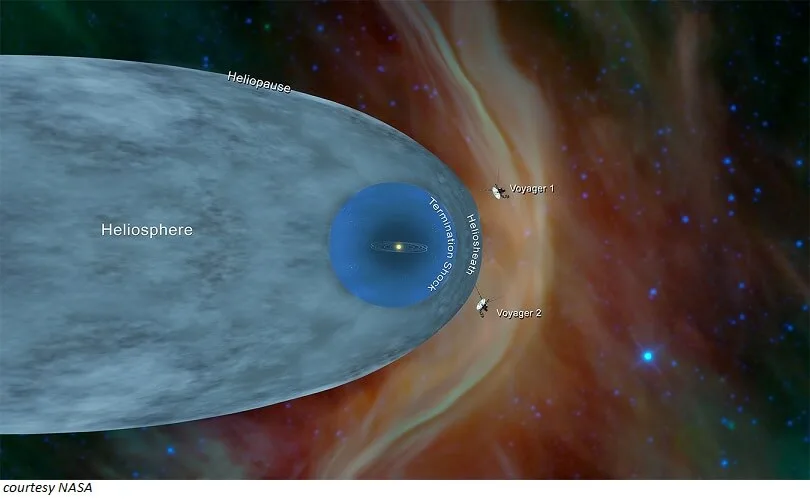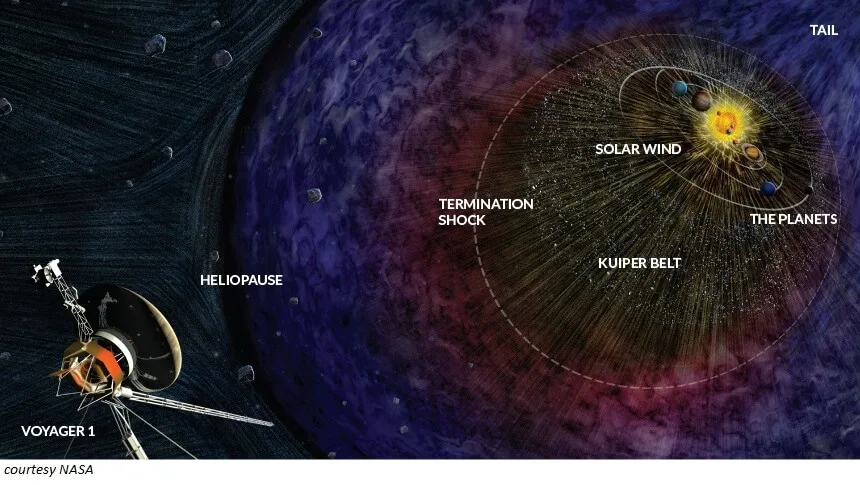
Curiosity is a mere desire to explore the things that one can only think and imagine. It is curiosity that differentiate human beings from other species on the planet. It is an innate and fundamental aspect of human nature and the result of the developed brain, that the human being possess. The desire to explore the vast space is one such result of the curiosity in human. With this curiosity the former USSR took initiative to explore the space and launched Sputnik, the first artificial satellite on 4th October 1957.
All this development was taking place during cold war. It compelled America to enter in the field of space exploration, through its agency NASA. On 1st October,1958, NASA too launched its first space project named Mercury. As the time passed by the curiosity to reach the edges of our vast solar system increased which gave birth to Voyager 1 and voyager 2 which were launched in different months of 1977. I like to inform my dear readers that Voyager 2 was launched before Voyager 1.
An Attempt behind Imagination
Both Voyager 1 and 2 were designed for a period of 5 years to study Jupiter, Saturn and the rings of Saturn. But no one knew that even the Voyager was curious to explore beyond its pre -determined mission making the flyby of Uranus and Neptune possible.
Voyager 1
The trajectory of Voyager 1 was designed in such a way that it would cross the largest moon of Saturn “Titan”. Further, it would study the rings of Saturn from behind. On 10th February 1979 Voyager 1 observed thin ring of Jupiter …Oh, yeah! I know what you all are thinking……rings are around Saturn not Jupiter……but let me tell you that not only Jupiter but Uranus too have rings but they are not as prominent as that of Saturn.
Ok, now coming back, Voyager 1 added two new moons to the Jupiter through its observation. Moreover, it discovered five new moons for Saturn while approaching towards it. Since it was determined to study Titan, it was not directed towards Uranus and Neptune and on 25th August,2012. It became the first human satellite to cross Heliosphere and enter into interstellar Space.
You might be thinking what this Heliosphere and Interstellar Space is so let’s learn about them. Heliosphere is the atmosphere of sun. It is created by the solar winds moving outward and preventing the interstellar wind entering the solar system. It is influenced by the magnetic field of the sun, high energetic particles and the solar wind plasma. The imaginary line that separated the heliosphere and the interstellar space is called Heliopause. There is no influence of sun beyond Heliopause. Whereas Interstellar Space is the space between the star’s system (such as our solar system) within a galaxy.

Voyager 2
Voyager 2’s trajectory to flyby Saturn was determined in such a way that Saturn itself can automatically direct the Voyager in the direction of Uranus. With the assumption that all the instruments of Voyager 2 would continue to work when it flyby Uranus, the mission was extended to study Neptune.
Voyager 2 started sending detailed photos of Uranus after coming close to it on 14th January,1986. During its journey it got only 5.5 hours to study Uranus. Voyager 2 reported 10 new moons and two new rings apart from nine rings previously known. Moreover, reported that the speed of winds on Uranus was more than 724 km/hour and it has a boiling ocean of water. Further in its journey it reached close to Neptune on 25th August,1989. It reported 6 new moons of Neptune and wind speed on Neptune to be approximately 1100 km/hour. It also added that the atmosphere of Neptune was dominated by Hydrogen. Wait this in not the end, it’s just a beginning! As this mission now became Trans Planetary as it started its Interstellar journey. It crossed the Heliopause on 5th November ,2018 to enter the interstellar space.
Breaking News: NASA losses its contact with Voyager 2
Located at a distance of over 12.3 billion miles away, Voyager 2 has titled its antenna away from the earth due to the wrong commands given to it. NASA lost contact with the satellite on July 21st which stopped the data transmission. NASA is waiting for a positive result when Voyager 2 will reset itself on October 15th as scheduled.
Voyager 2 stands as a testament to human hard work, dedication behind its curiosity to explore the space. The spacecraft’s epic journey continues to inspire international scientists, space enthusiasts, and dreamers worldwide. As it ventures into the dark universe, it reminds us that there is so much more out there waiting to be discovered. So, let’s hope that the scheduled reset re-establishes the data transmission. And we are showered by the undiscovered facts of the infinite space.

Nice article
Important information
Very informative article
👌👍👍